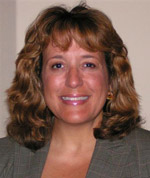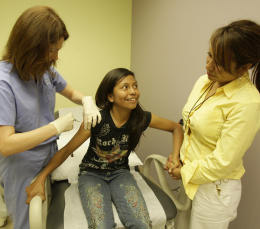Merck no match for L.A. County pharmacy director
May 5, 2009
L.A County Pharmacy Director Amy Gutierrez was determined to make pharmaceutical giant Merck & Co. live by its corporate motto: “Where patients come first.”
Merck, she says, was balking at providing free doses of the cervical cancer vaccine Gardasil to uninsured young women no longer eligible to receive the drug through a state administered program.
Gardasil, which has proven to be about 75% effective in preventing cervical cancer, is recommended for women between the ages of 9 and 26. But California offers free vaccines to uninsured women only up to the age of 18. Gutierrez wanted to make sure that no woman would be denied the vaccine because of her age or insurance status.
Merck executives saw it differently.

L.A County Pharmacy Director Amy Gutierrez
“It was an arbitrary decision that I thought was insulting,” says Gutierrez, who’s headed the pharmacy for three years.
Last summer, Gutierrez began pushing Merck hard on the phone and in writing, with help from Dr. Robert Israel, an OB-GYN who oversees women’s health clinics at LAC+USC medical center. She also enlisted the interim chief medical officer of the county’s health services department, Dr. Robert G. Splawn.
In July, the two co-signed a sharply worded letter to Merck, explaining once again the importance of providing Gardasil to uninsured and vulnerable women between the ages of 19 and 26 at county medical facilities. Denying the vaccine to these patients simply because they’re being seen in a public hospital or clinic, they wrote, “is not logical, nor is it consistent with the stated objectives” of Merck’s patient assistance program, to provide vaccines to those who can’t pay.
Not so subtly, the two also reminded Merck that Los Angeles County is a big customer, spending more than $9 million annually on the company’s various drugs.
Still, Merck held fast to its position, saying it was waiting for the results of a pilot program with public agencies in several states before proceeding, a program for which California had not applied. So Gutierrez and her staff decided to turn up the heat, making Merck aware that the county had begun scrutinizing certain big-ticket purchases from the company.
Concerned by the county’s move, Merck executives called to discuss the situation. But the pharmacy director says she told them: “There’s only one item on the agenda that I want to talk about.”
One month later, in mid-December, Gutierrez says she got “a great Christmas present”—an e-mail from a top Merck executive.
“Hello Dr. Gutierrez,” the note began, “I wanted to confirm that we have altered our policy such that public institutions and entities are now eligible to utilize the current Vaccine Patient Assistance Program in the same manner and to the same extent as private institutions and entities.”
Merck’s dramatic shift in policy was not only good news for Los Angeles County but for every county in the U.S., where the vaccine and other designated drugs can now be distributed through public hospitals and clinics.
“I never thought I could do something to change the policy,” says Gutierrez, whose three daughters have all been vaccinated with Gardasil. “But if you have enough persistence, you can pull it off.”
 In February, the county started administering Gardasil through the LAC+USC Healthcare Networks. Dr. Israel, the women’s health expert and a USC professor, says dosages are being provided to about 25 women a month. In the weeks ahead, he says, other county facilities, such as Olive View Hospital, will begin the vaccination program.
In February, the county started administering Gardasil through the LAC+USC Healthcare Networks. Dr. Israel, the women’s health expert and a USC professor, says dosages are being provided to about 25 women a month. In the weeks ahead, he says, other county facilities, such as Olive View Hospital, will begin the vaccination program.
Even then, however, he does not expect the numbers of participants to be large because, for the most part, women between the ages of 19 and 26 who show up at county facilities with gynecological issues already are confronting serious medical problems. For them, he says, the vaccine is down the list of priorities.
“We opened the door,” he says of the vaccine’s availability. “I didn’t expect we were going to kick the door down.”
Health professionals hope that, in the future, there’ll be no need to provide Gardasil in this older age group. The goal, they say, is for the vaccine to be administered to all girls at an early age, before they have sexual intercourse and become vulnerable to strains of the human papilloma virus that cause cervical cancer.
Until then, Gutierrez says, she’ll continue to spread the word. “If we can in any way impact cervical cancer in L.A., we’ve succeeded.”












 405 bridge work causes a stink
405 bridge work causes a stink
